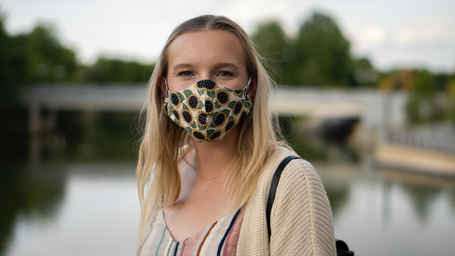As a recent addition to 2020 terminology, “maskne” refers to the acne that wearing a mask specifically causes—it is a clever combination of the two words. Maskne is just another one of those annoying outcomes of the pandemic the coronavirus has forcibly pushed us in. Unless you have perfect, immaculate skin, you’ve likely dealt with maskne already, as masks are now a centerpiece for our daily outfits and outings.
According to Elizabeth Mullans, M.D., a board-certified dermatologist, maskne is a result of sweat, skin oils and bacteria getting trapped on the skin while wearing a mask. Masks leave the face vulnerable to all these pore-clogging substances by constantly rubbing the skin, causing irritation and the breakdown of the skin’s protective barrier. Wearing a mask throughout the day on a regular basis inevitably causes the face to excessively sweat, especially when wearing a mask outside. Excessive moisture trapped under the mask acts as a catalyst for the overgrowth of the skin’s healthy bacteria and yeast, which is what leads to pimples and cysts in the affected area. While a full summer of mask-wearing has brought us clogged pores, the colder months will bring dry, delicate skin that masks can easily irritate and damage.
The struggles of maskne may seem to be almost unavoidable if the right precautions aren’t practiced. After dealing with a mild breakout of maskne when I first moved to college, I desperately searched the internet for ways to cure it. The following tips are what has personally helped me retain clear skin while constantly wearing a mask. I highly recommend these tips to anyone dealing with maskne as they are general and can be personalized to anyone’s unique skin. Of course, I am by no means a dermatologist. But these simple tips saved my delicate, sensitive skin, and hopefully, they can help save your skin too.

Tip #1: Wash your face.
Washing your face at least twice a day can significantly help remove excess oils and bacteria. You can gently wash your face with water, which I usually do if I’ve been wearing a mask outside and my face is super sweaty. You can also wash it with a gentle cleanser, which is what I do in the morning and sometimes at night. I use the Ole Henriksen Truth Juice Daily Cleanser.
Tip #2: Put sunscreen on your face in the morning and exfoliate properly at night.
Wearing sunscreen on a daily basis gives your skin the protective layer it needs. The sunscreen acts as a barrier between your skin and all the pore-clogging substances the masks buildup. Wearing a gentle and moisturizing SPF has greatly helped my skin stay clear and free of irritation. I use the Kiehl’s Ultra Facial Moisturizer SPF 30. Yes, I know sunscreen is annoying, but trust me your skin needs it. Moisturizing in the morning is just as important as it is at night. Exfoliating at night is especially important. After a long day of your mask clogging those pores, applying a chemical exfoliator, specifically salicylic acid, to your face helps your skin stay clean and even. I use Paula’s Choice 2% BHA Liquid Exfoliant, and it’s only 10 bucks! Incorporating salicylic acid into my nightly skincare routine has done absolute wonders for clearing and minimizing my pores and smoothing out my skin tone.
Tip #3: Wash your reusable masks and do not reuse disposable ones.
Reusable masks collect dirt, sweat and oils when worn repeatedly without being washed. To minimize your skin’s exposure to the buildup of all those substances that have been on your face for days, simply wash the mask in your next load of laundry. Avoid using harshly fragrant detergents and dryer sheets because those can easily irritate sensitive skin. If you wear disposable masks, simply don’t reuse them. These masks are fairly cheap and can be bought in large quantities so you can always have a fresh, new mask readily available.
Tip #4: If you have the option, do not put makeup on the area of skin the mask covers.
Makeup is just another substance that is notorious for clogging pores and causing acne, especially if you don’t take it off at night. Always remove your makeup at night!! Makeup mixed with excessive sweat underneath a mask is a recipe for disaster if not properly navigated. Ladies, if you feel like you must wear makeup in the area your mask covers, apply as little as possible. Keep the layers thin so your skin can breathe. If makeup is not necessary for that part of the face, not wearing it does a great service to your skin. If you do wear makeup in the mask covered area of your face, do your best to make sure your mask stays dry and clean.
Tip # 5: Be wary of what type of mask you are using.
The material of your mask plays a major part in how your skin reacts to wearing it. The optimal choice of mask material is soft cotton; this material’s gentle texture reduces inflammation and redness often caused by rubbing and irritation. Put on a clean mask at the beginning of the day and continue using clean masks throughout the day. If you work out in a mask, wear a mask that least hinders your breathing, wash your hands before taking off the mask and then wash your face immediately after taking off the mask. If you want to splurge a little on a high-quality mask that reduces the risk of maskne, purchase a silk mask or a specifically anti-acne mask, such as the one MDacne sells. If the quality and stability of your skin are important to you, investing in the right material can make all the difference.
Want to see more HCFSU? Be sure to like us on Facebook and follow us on Instagram, Twitter, TikTok and Pinterest!



